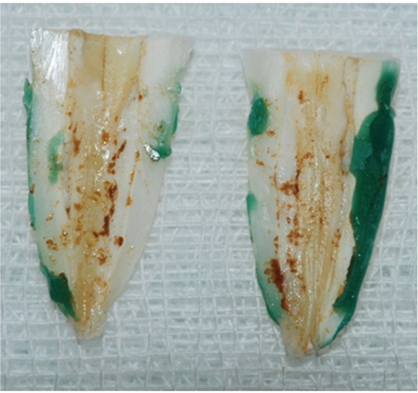Restor Dent Endod.
2012 Aug;37(3):185-186. 10.5395/rde.2012.37.3.185.
Precipitate from a combination of sodium hypochlorite and chlorhexidine
- Affiliations
-
- 1Gangneung-Wonju National University, Korea.
- KMID: 1995661
- DOI: http://doi.org/10.5395/rde.2012.37.3.185
Abstract
- No abstract available.
Figure
Reference
-
1. Byström A, Sundqvist G. Bacteriologic evaluation of the efficacy of mechanical root canal instrumentation in endodontic therapy. Scand J Dent Res. 1981. 89:321–328.
Article2. Orstavik D, Haapasalo M. Disinfection by endodontic irrigants and dressings of experimentally infected dentinal tubules. Endod Dent Traumatol. 1990. 6:142–149.
Article3. Basrani BR, Manek S, Mathers D, Fillery E, Sodhi RN. Determination of 4-chloroaniline and its derivatives formed in the interaction of sodium hypochlorite and chlorhexidine by using gas chromatography. J Endod. 2010. 36:312–314.
Article4. Estrela C, Estrela CR, Barbin EL, Spanó JC, Marchesan MA, Pécora JD. Mechanism of action of sodium hypochlorite. Braz Dent J. 2002. 13:113–117.
Article5. Siqueira JF Jr, Batista MM, Fraga RC, de Uzeda M. Antibacterial effects of endodontic irrigants on black-pigmented gram-negative anaerobes and facultative bacteria. J Endod. 1998. 24:414–416.
Article6. Leonardo MR, Tanomaru Filho M, Silva LA, Nelson Filho P, Bonifácio KC, Ito IY. In vivo antimicrobial activity of 2% chlorhexidine used as a root canal irrigating solution. J Endod. 1999. 25:167–171.
Article7. Dametto FR, Ferraz CC, Gomes BP, Zaia AA, Teixeira FB, de Souza-Filho FJ. In vitro assessment of the immediate and prolonged antimicrobial action of chlorhexidine gel as an endodontic irrigant against Enterococcus faecalis. Oral Surg Oral Med Oral Pathol Oral Radiol Endod. 2005. 99:768–772.
Article8. Kuruvilla JR, Kamath MP. Antimicrobial activity of 2.5% sodium hypochlorite and 0.2% chlorhexidine gluconate separately and combined, as endodontic irrigants. J Endod. 1998. 24:472–476.
Article9. Zehnder M. Root canal irrigants. J Endod. 2006. 32:389–398.
Article10. Vivacqua-Gomes N, Ferraz CC, Gomes BP, Zaia AA, Teixeira FB, Souza-Filho FJ. Influence of irrigants on the coronal microleakage of laterally condensed gutta-percha root fillings. Int Endod J. 2002. 35:791–795.
Article11. Basrani BR, Manek S, Sodhi RN, Fillery E, Manzur A. Interaction between sodium hypochlorite and chlorhexidine gluconate. J Endod. 2007. 33:966–969.
Article12. Bui TB, Baumgartner JC, Mitchell JC. Evaluation of the interaction between sodium hypochlorite and chlorhexidine gluconate and its effect on root dentin. J Endod. 2008. 34:181–185.
Article13. Chhabra RS, Huff JE, Haseman JK, Elwell MR, Peters AC. Carcinogenicity of p-chloroanaline in rats and mice. Food Chem Toxicol. 1991. 29:119–124.14. Barbin LE, Saquy PC, Guedes DF, Sousa-Neto MD, Estrela C, Pécora JD. Determination of para-chloroaniline and reactive oxygen species in chlorhexidine and chlorhexidine associated with calcium hydroxide. J Endod. 2008. 34:1508–1514.
Article15. Choi MS, Park SH, Cho KM, Kim JW. The comparison of different canal irrigation methods to prevent reaction precipitate between sodium hypochlorite and chlorhexidine. J Korean Acad Conserv Dent. 2010. 35:80–87.
Article
- Full Text Links
- Actions
-
Cited
- CITED
-
- Close
- Share
- Similar articles
-
- The comparison of different canal irrigation methods to prevent reaction precipitate between sodium hypochlorite and chlorhexidine
- Chlorhexidine gel associated with papain in pulp tissue dissolution
- Effect of three different irrigation solutions applied by passive ultrasonic irrigation
- Evaluation of time-dependent antimicrobial effect of sodium dichloroisocyanurate (NaDCC) on Enterococcus faecalis in the root canal
- Evaluation of Sodium Dichloroisocyanurate as a root canal irrigation solution; Cl- concentration, pH, Cytotoxicity and Antimicrobial effect in vitro


